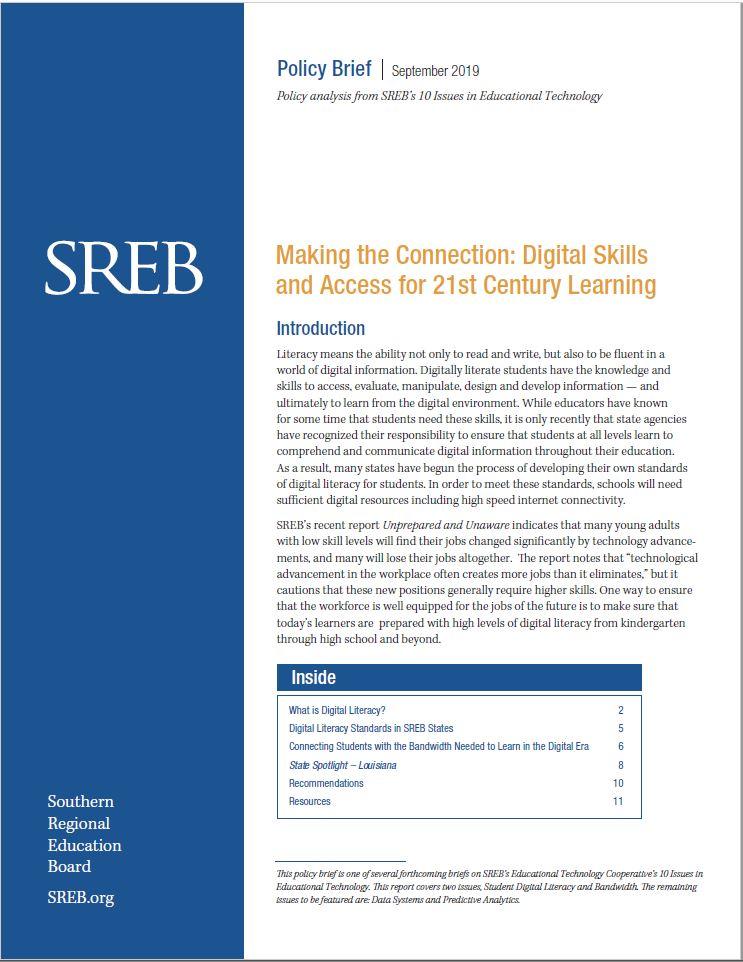Bandwidth
Bandwidth
Expand reliable, affordable bandwidth to ensure that educators and their students gain maximum benefit from current and emerging technologies.
As teachers, staff and students bring more of their electronic devices to school or college, demand for broadband to support them consumes more of the institution’s bandwidth capacity. Many institutions are limited in what they have available and cannot provide sufficient bandwidth for teaching and learning. As digital learning and communication expands, access to affordable internet connectivity — or broadband — is a continuing struggle for K-12 schools and postsecondary education.
The nonprofit EducationSuperHighway reported in January 2017 that 88 percent of school districts meet the FCC minimum internet access goal of 100 kbps per student. But as states adopt personalized or blended digital learning strategies, schools will need to meet the significantly higher 2018 FCC goal of 1 Mbps per student — a level only 15 percent of school districts met by mid-2017. Moreover, they will need to be prepared to keep up with the 50 percent year-over-year growth in demand for bandwidth.
More than 11.6 million of the nation’s students, in 19,000 schools, are without the minimum connectivity necessary for digital learning. Although broadband costs have gone down, to reach the affordability goal of $3 per Mbps, states will need to partner with broadband providers and education networks for mutually beneficial outcomes.
What is the issue and why is it important?
TestMyNet has compared the speeds for Internet uploads and downloads for universities and posted their results. (It has not compared speeds for community or technical colleges.) In June 2014, Valore Books partnered with TestMyNet to determine the 25 colleges with the highest broadband speeds. The most compelling finding was the vast difference between the fastest and slowest speeds, a result that is typical for K-12 schools — another difference between the “haves” and “have nots.” Download speeds ranged from 5.7 Mbps to 98.96 Mbps and upload speeds from 3.2 Mbps to 49.1 Mbps.
Many higher education institutions rely on a state or regional research and education network to provide affordable broadband, and some partner with providers like Google and Internet2 or form multi-institution cooperatives for volume pricing. Even though fiber optic networks provide the highest capacity, thousands of miles of “dark fiber” (unused fiber optics) are available for lease in the United States, and too few colleges and schools take advantage of this. Still, the United States lags behind many other countries in fiber optic capacity. According to Google, about 9 percent of connections in the United States are fiber, compared with 71 percent in Japan and 66 percent in Korea.
What if SREB states do not make adequate progress on this issue?
Without adequate high-speed fiber optic bandwidth access, SREB states will be stalled in implementing projects that are integral to meeting state goals and improving student learning. Although states have made good progress with data systems, they can realize the full benefits of evidence-based decision making only by completing the following actions.
-
Developing online instruction and online assessment for use with state readiness standards and testing programs
-
Building instructional collaboration between K-12 and higher education, especially in STEM areas, as well as collaboration with peers and experts around the globe
-
Implementing internet-based tools that provide live, streaming video or audio of teachers in their classrooms to allow evaluators to observe teachers and assess their effectiveness
-
Providing cloud-based services for securely storing and accessing high quantities of instructional, administrative or research data
-
Supporting new or improved instructional models such as flipped classrooms, adaptive learning courses, digital content, gaming, simulations, virtual and personalized learning models
-
Providing online postsecondary degree/certificate programs, with all the attendant advisement, registration, library, and student support services, including artificial intelligence for personalized learning and tutoring
-
Providing university access to high-powered computers and databases for research
-
Implementing internet-based applications to manage campus security, energy and telecommunications to achieve cost savings and greater safety and security
-
Accommodating student-owned devices (Bring Your Own Device, or BYOD) so that students can integrate their technology into academic learning environments
-
Increasing use of sensors and devices, known as the Internet of Things




